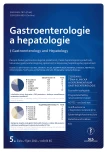Prognostic factors and timing of endoscopy in acute non-variceal upper gastrointestinal bleeding
Authors:
T. Koller 1; J. Sekáč 2; M. Huorka 1; M. Nagyová 1; T. Hlavatý 1; J. Payer 1
Authors‘ workplace:
V. interná klinika, LF UK a UN Bratislava
1; II. chirurgická klinika, LF UK a UN Bratislava
2
Published in:
Gastroent Hepatol 2011; 65(5): 286-293
Category:
Digestive Endoscopy: Original Article
Overview
Purpose and objectives:
Identification of causes, endoscopic findings and clinical course of acute non-variceal upper-GI bleeding, determining the rate of re-bleeding, surgical treatment and mortality within 40 days, followed by the identification of independent prognostic factors and the importance of the timing of endoscopy.
Methods:
Consecutive patients with acute non--variceal bleeding over a period of 2 years were studied, patients with variceal bleeding and lower-GI bleeding were excluded. We recorded medical history, hemodynamic variables, endoscopic findings and degree of bleeding lesions, number of transfusions, interval from admission to endoscopy, the rate of re-bleeding, surgical treatment and mortality.
Results:
163 patients with a mean age of 65.14 years, with women accounting for 42.9%, were studied. Peptic lesions of the stomach or duodenum were the source in 78.5% of cases, active bleeding represented 19%, endoscopic treatment was applied in 49.1% of patients. Re-bleeding was observed in 5.5% and 4.3% of patients underwent surgical treatment, mortality was 12.9%. In multivariate analysis, independent predictors of death were the clinical Rockall score > 3 (OR, odds ratio = 12.54; p = 0.0014) with 90.5% sensitivity and 97.8% negative predictive value, treatment with steroids or selective serotonin reuptake inhibitors (SSRI) (OR = 5.14; p = 0.045) and the lowest recorded haemoglobin concentration (OR = 2.96; p = 0.031). Endoscopy within 6 hours of admission identified more higher-risk lesions and more frequently led to endoscopic treatment. However, no difference was found in transfusion requirements, recurrence of bleeding, surgery or death.
Conclusion:
Rockall score > 3 was the strongest independent prognostic factor of death and these patients should merit urgent management. In a subgroup of patients with endoscopy within 6 hours of admission, endoscopic treatment was applied more often with no advantages in the clinical outcome.
Key words:
hemorrhage – gastrointestinal – prognosis – endoscopy
Sources
1. Hearnshaw SA, Logan RF, Lowe D et al. Acute upper gastrointestinal bleeding in the UK: patient characteristics, diagnoses and outcomes in the 2007 UK audit. Gut 2011; Jun. 10 epub.
2. Dítě P, Novotný I, Kroupa R et al. Akutní nevarikózní krvácení do horní části trávicího traktu, Čes a Slov Gastroent a Hepatol 2007; 61(1): 6–10.
3. Parente F, Anderloni A, Bargiggia S et al. Outcome of non-variceal acute upper gastrointestinal bleeding in relation to the time of endoscopy and the experience of the endoscopist: a two-year survey. World J Gastroenterol 2005; 11(45): 7122–7130.
4. Barkun AN, Bardou M, Kuipers EJ et al. International consensus recommendations on the management of patients with nonvariceal upper gastrointestinal bleeding. Ann Intern Med 2010; 152(2): 101–113.
5. Rockall TA. Risk scoring in acute upper gastrointestinal haemorrhage. Dig Liver Dis 2006; 38(1): 10–11.
6. Blatchford O, Murray WR, Blatchford M. A risk score to predict need for treatment for upper-gastrointestinal haemorrhage. Lancet 2000; 356(9238): 1318–1321.
7. Alkhatib AA, Abubakr SM, Elkhatib FA. An estimate of hospitalization cost for elderly patients with acute upper gastrointestinal bleeding in the USA. Dig Dis Sci 2009; 54(3): 695.
8. Barkun A, Sabbah S, Enns R et al. The Canadian Registry on Nonvariceal Upper Gastrointestinal Bleeding and Endoscopy (RUGBE): Endoscopic hemostasis and proton pump inhibition are associated with improved outcomes in a real-life setting. Am J Gastroenterol 2004; 99(7): 1238–1246.
9. Morales Uribe CH, Sierra Sierra S, Hernández AM et al. Upper gastrointestinal bleeding: risk factors for mortality in two urban centres in Latin America. Rev Esp Enferm Dig 2011; 103(1): 20–24.
10. González-González JA, Vázquez-Elizondo G, García-Compeán Da et al. Predictors of in-hospital mortality in patients with non-variceal upper gastrointestinal bleeding. Rev Esp Enferm Dig 2011; 103(4): 196–203.
11. Fein F, Weber A, Koch S et al. The prognosis of patients having received optimal therapy for nonvariceal upper gastrointestinal bleeding might be worse in daily practice than in randomized clinical trials. Eur J Gastroenterol Hepatol 2010; 22(3): 361–367.
12. Scottish Intercollegiate Guidelines Network, Management of acute upper and lower gastrointestinal bleeding, A national clinical guideline: Elliott House Edinburgh 2008 : 5–9.
13. Tham TC, James C, Kelly M. Predicting outcome of acute non-variceal upper gastrointestinal haemorrhage without endoscopy using the clinical Rockall Score. Postgrad Med J 2006; 82(973): 757–759.
14. Stanley AJ, Dalton HR, Blatchford O et al. Multicentre comparison of the Glasgow Blatchford and Rockall scores in the prediction of clinical end-points after upper gastrointestinal haemorrhage. Aliment Pharmacol Ther 2011; 34(4): 470–475.
15. Romagnuolo J, Barkun AN, Enns R et al. Simple clinical predictors may obviate urgent endoscopy in selected patients with nonvariceal upper gastrointestinal tract bleeding. Arch Intern Med 2007; 167(3): 265–270.
16. Mařatka Z. Krvácení z trávicí trubice. In: Praktická Gastroenterologie. Státní zdravotnické nakladatelství 1968 : 491–493.
17. Dítě P. Akutni nevarikózní krvácení do horní částí trávicího ústrojí. In: Akutní stavy v Gastroenterologii. Praha: Galén 2005 : 9–19.
18. Cooper GS, Kou TD, Wong RC. Use and impact of early endoscopy in elderly patients with peptic ulcer hemorrhage: a population-based analysis. Gastrointest Endosc 2009; 70(2): 229–235.
19. Lim LG, Ho KY, Chan YH et al. Urgent endoscopy is associated with lower mortality in high-risk but not low-risk nonvariceal upper gastrointestinal bleeding. Endoscopy 2011; 43(4): 300–306.
Labels
Paediatric gastroenterology Gastroenterology and hepatology SurgeryArticle was published in
Gastroenterology and Hepatology

2011 Issue 5
Most read in this issue
- Eosinophilic esophagitis
- Two faces of oesophageal cancer – epidemiology and etiology
- Radiofrequency ablation in the GI tract – the “state of the art” in the Czech Republic and worldwide
- Prognostic factors and timing of endoscopy in acute non-variceal upper gastrointestinal bleeding
